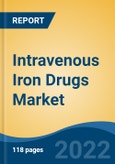Speak directly to the analyst to clarify any post sales queries you may have.
10% Free customizationThis report comes with 10% free customization, enabling you to add data that meets your specific business needs.
The growing prevalence of anemia related to chronic conditions such as chronic kidney disease (CKD), inflammatory bowel disease (IBD), heart failure, and cancer is a major factor propelling demand. The introduction of safer, next-generation IV iron formulations has also improved clinical adoption by reducing adverse reactions and eliminating the need for test dosing. These advancements, combined with increasing awareness among healthcare professionals, are enhancing the appeal and accessibility of IV iron therapy in both developed and developing healthcare systems.
Key Market Drivers
Growth in Healthcare Industry
The rapid growth of the global healthcare sector continues to be a fundamental driver of the intravenous iron drugs market. With annual revenues exceeding USD 4 trillion, the healthcare industry includes key segments like pharmaceuticals, biotechnology, and diagnostics - each contributing significantly to the expansion of IV therapies.Chronic diseases such as CKD, IBD, and cancer are increasingly diagnosed and treated as healthcare infrastructure improves globally. This has elevated the demand for iron supplementation, particularly in cases of iron-deficiency anemia that require immediate and effective intervention. By 2026, the number of hospitals worldwide is projected to reach 215,977, driven primarily by growth in regions like China, the Far East, and parts of Africa and the Middle East. With rising numbers of specialty clinics, diagnostic centers, and infusion-equipped facilities, the uptake of IV iron therapies is becoming more widespread, further fueling market momentum.
Key Market Challenges
High Cost of Treatment
A major hurdle facing the intravenous iron drugs market is the relatively high cost of treatment. Newer formulations such as ferric carboxymaltose and iron isomaltoside entail higher costs than conventional oral supplements. These expenses encompass drug prices, administration services, medical staff, and monitoring post-infusion, especially in hospital or clinic settings.This cost factor poses a significant barrier in resource-limited countries where public health budgets are constrained. Even in advanced healthcare systems, variations in insurance coverage and high out-of-pocket costs can impede access to IV iron therapies. These economic barriers restrict wider adoption and make cost-containment strategies critical to expanding market reach.
Key Market Trends
Increasing Focus on Maternal and Pediatric Health
A notable trend influencing the intravenous iron drugs market is the growing emphasis on improving maternal and pediatric health outcomes. Iron-deficiency anemia remains prevalent among pregnant women and children, particularly in low- and middle-income countries. Sub-Saharan Africa alone accounts for roughly 70% of global maternal deaths, underlining the urgent need for effective interventions.IV iron therapy is increasingly recognized as a preferred treatment for moderate to severe anemia during pregnancy, especially when oral supplements prove ineffective. Timely administration helps reduce the risk of complications such as low birth weight, preterm labor, and postpartum hemorrhage. This trend is supported by heightened awareness among healthcare professionals and the inclusion of IV iron in prenatal care protocols, signaling continued market growth in this segment.
Key Market Players
- AMAG Pharmaceuticals, Inc.
- Vifor Pharma Management Ltd.
- Daiichi Sankyo Company, Limited
- Rockwell Medical Inc.
- Allergan PLC
- Pfizer Inc.
- Nippon Shinyaku Co.
- Novartis International AG
- Takeda Pharmaceutical Company Limited
- Bausch Health Companies Inc.
Report Scope
In this report, the Global Intravenous Iron Drugs Market has been segmented into the following categories, in addition to the industry trends which have also been detailed below:Intravenous Iron Drugs Market, By Product:
- Iron Dextran
- Ferric Gluconate
- Iron Sucrose
- Ferric Carboxymaltose
- Iron Isomaltoside 1000
- Ferumoxytol
Intravenous Iron Drugs Market, By Application:
- Intestinal Malabsorption Syndromes
- Inflammatory Diseases
- Gastrectomy/Bariatric Surgery
- Anemia
- Osier-Weber-Rendu Disease
- Angiodysplasia
- Pregnancy
- Others
Intravenous Iron Drugs Market, By Region:
- North America
- United States
- Canada
- Mexico
- Europe
- France
- United Kingdom
- Italy
- Germany
- Spain
- Asia Pacific
- China
- India
- Japan
- Australia
- South Korea
- South America
- Brazil
- Argentina
- Colombia
- Middle East & Africa
- South Africa
- Saudi Arabia
- UAE
Competitive Landscape
Company Profiles: Detailed analysis of the major companies present in the Global Intravenous Iron Drugs Market.Available Customizations
With the given market data, the publisher offers customizations according to a company's specific needs. The following customization options are available for the report.Company Information
- Detailed analysis and profiling of additional market players (up to five).
This product will be delivered within 1-3 business days.
Table of Contents
Companies Mentioned
- AMAG pharmaceuticals, Inc.
- Vifor Pharma Management Ltd.
- Daiichi Sankyo Company, Limited
- Rockwell Medical Inc.
- Allergan PLC
- Pfizer Inc.
- Nippon Shinyaku Co.
- Novartis International AG
- Takeda Pharmaceutical Company Limited
- Bausch Health Companies Inc.
Table Information
| Report Attribute | Details |
|---|---|
| No. of Pages | 185 |
| Published | June 2025 |
| Forecast Period | 2024 - 2030 |
| Estimated Market Value ( USD | $ 2.46 Billion |
| Forecasted Market Value ( USD | $ 3.39 Billion |
| Compound Annual Growth Rate | 5.7% |
| Regions Covered | Global |
| No. of Companies Mentioned | 10 |









